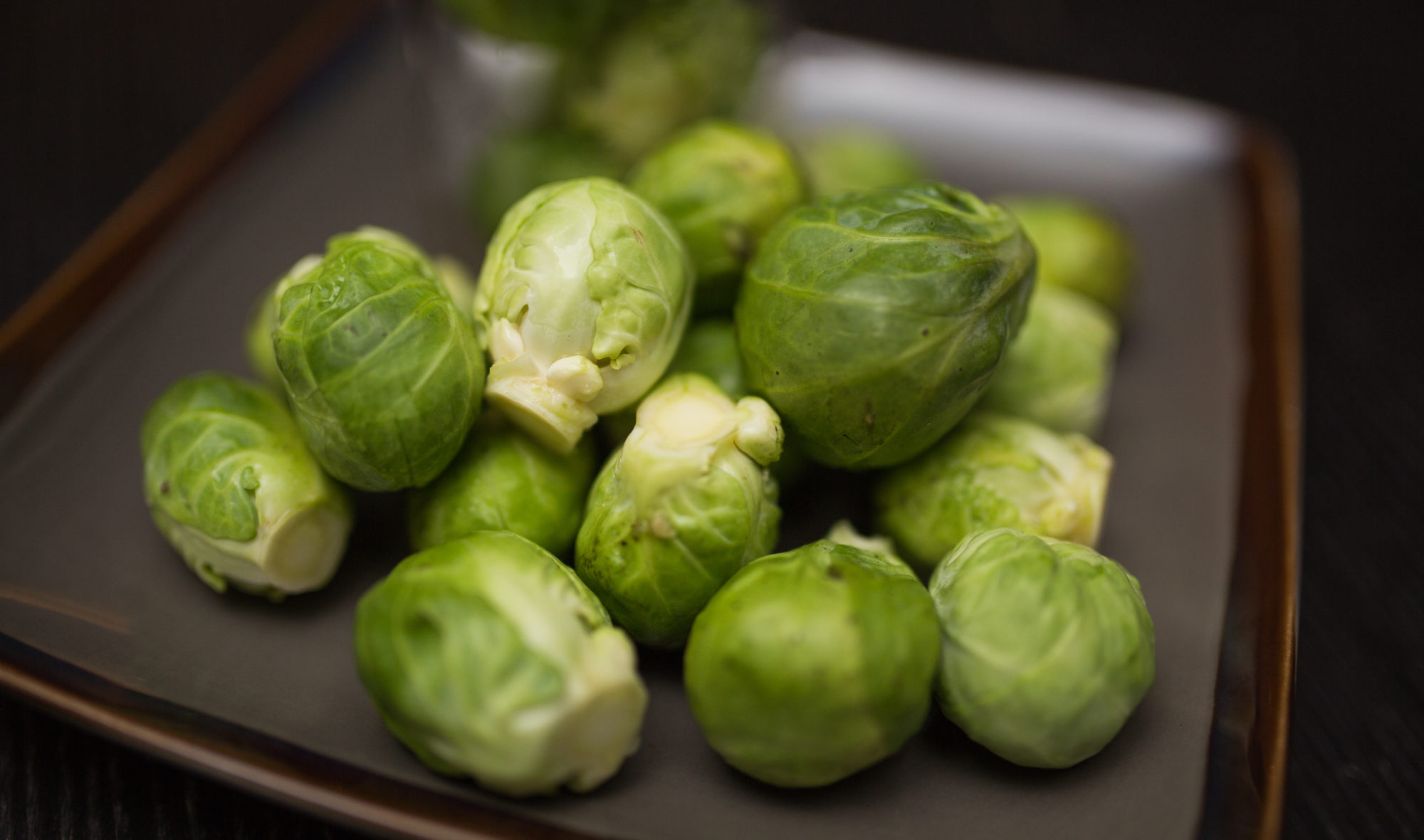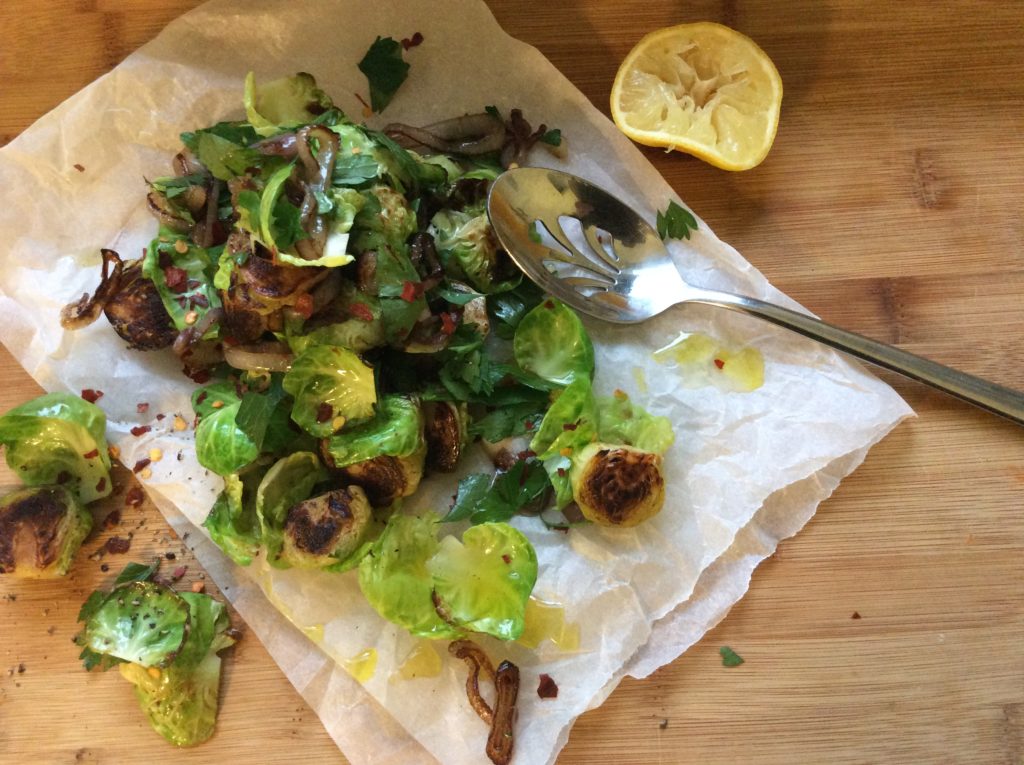
Join PN Level 2 for less than $9 USD/day! Affordable monthly payments now open.

Brussels sprouts are cruciferous vegetable that look like miniature green cabbages (and indeed they are a part of the cabbage family.) Nutritionally, Brussels sprouts are small but mighty: they offer fiber, a range of vitamins and minerals, and even antioxidants. To prepare Brussels sprouts, remove the blunt end and the outer leaves before cooking. For best results, don’t overcook Brussels sprouts: it’s overcooking that is responsible for their sometimes unfavorable reputation. Cooked properly (for example, by roasting or sautéing), Brussels sprouts can be downright delicious.
Brussels sprouts are a cruciferous vegetable. As a Brassica, they are part of the cabbage family, along with broccoli, kale, and collard greens. The edible buds (the “sprouts” themselves) grow on a long, thick stalk, and look like miniature cabbages.
It has been suggested that Brussels sprouts were first cultivated in Belgium – hence the name. Today, they can be found in many cool, temperate climates, coming into season between September and March. As a result they are generally considered a fall or winter vegetable.
Among certain audiences (especially children) Brussels sprouts have a reputation for being unpalatable or even downright “stinky.” This unfair notion may have emerged from the fact that cabbages – when overcooked – can emit a sulfur smell. However, properly prepared Brussels sprouts can be quite tasty as well as nutritious; they have a mildly sweet, nutty flavor.
Brussels sprouts are small green buds made up of many tightly formed layers: they look like tiny cabbages.
The leaves are usually bright green, sometimes tinted yellow, and of slightly lighter color inside the cabbage.
Brussels sprouts are usually found removed from the stalk, though occasionally at farmers’ markets you may be able to find fresh stalks with the edible buds still attached. The stalk is quite large and the visual impact impressive.
One cup of Brussels sprouts has about 38 calories, 3.0g of protein, 0.3g of fat, 7.9g of carbohydrates, 3.3g of fiber, and 1.9g of sugar.
Brussels sprouts are nutritional powerhouses. In addition to fiber, they are an excellent source of vitamin C and K, as well as iron, manganese, folate, and carotenoids. They are also considered a source of antioxidants.
Brussels sprouts are usually sold loose in the produce section of your grocery store or market; this is preferable to buying them in pre-packaged bags. If possible, take your time to pick through the sprouts to select the freshest, best looking sprouts you can get.
Look for crisp, tight leaves with a bright green color. Avoid sprouts with leaves that are overly wilted, discolored, or decaying. Some yellowing or spotting is normal, but look for color consistency as much as possible. (Yellowing and wilting is a sign of age.)
Tip: smaller, firmer sprouts tend to be sweeter and better tasting than larger, leafier sprouts.
If you can find fresh looking Brussels sprouts on the stalk (at a farmers’ market for example) that may be your chance at the freshest tasting sprouts; however, buying them in bulk is just fine as long as they exhibit the above signs of freshness.
Keep the sprouts in an open plastic bag in your refrigerator crisper; they should keep for a week or more.
Once cooked, Brussels sprouts will keep in an airtight container for several days.
If you’ve purchased a whole stalk, remove the sprouts where the bud meets the stalk using a sharp paring knife. In most cases, you won’t have to bother with this step.
To prepare the Brussels sprouts, trim the flat stump with a sharp knife and remove the first layer of leaves surrounding the sprout. (They will likely fall or easily peel off.) If there is any discoloration, just peel off the layers of leaves until the fresher, healthier part of the sprout is revealed.
You can then leave the sprouts whole (suitable for boiling), or halve or quarter the sprouts (ideal for roasting or steaming). If you would like to serve the sprouts raw in a salad, you may choose to halve them, then slice thinly into ribbons.
Brussels sprouts pair well with savory fall flavors. For example, try roasting them among a medley of vegetables such as butternut squash, mushrooms, shallots, and potatoes. The slight bitterness of the sprouts also responds well to the addition of rich, fatty flavors such as bacon, cream, or Parmesan cheese.
To roast Brussels sprouts, prepare and halve them as described above. Bring an oven to 475 degrees Fahrenheit. Place the sprouts in a baking dish or on a baking sheet, drizzle them with olive oil, and sprinkle with salt and pepper. Roast for 10 minutes; stir, then return to the oven for about 5 minutes longer. When cooked, the sprouts should have a golden-brown hue.
No matter the preparation, avoid overcooking the sprouts: they should be fork-tender and retain their bright color. If your sprouts turn out mushy, grey-ish or with a strong odor, reduce the cooking time. You may also find better results by changing up the cooking method: while boiling, steaming, and microwaving are all perfectly good options, roasting is one of the best ways to deliver a sweet, caramelized, nutty flavor from the sprouts. Stinkiness not required.

Adding charred Brussels sprouts to your meal repertoire is a game changer. These Brussels sprouts get a kick from the chilli and nice perkiness from the lime - a perfect way to balance the charred smokiness of the sprouts.
Prep Time: 10 minutes Cook Time: 10 minutes Yield: 4 sides
Set a large frying pan over medium-high heat. In a small bowl, mix together the brussels sprouts, half of the salt, and the olive oil. Pour into the hot pan, turning the sprouts so they are cut side down in the pan. Cook the sprouts, not moving them too much, until they get a nice dark caramel colour, about 5 minutes. Add the coconut oil, green onions, and chilli and turn the heat to high. Cook, stirring often until the green onions get dark and crispy, about 4 minutes. Remove from the heat and add the parsley. Finish with the remaining salt, pepper, and a squeeze of lime.
Precision Nutrition’s Encyclopedia of Food expands every single month as we highlight new foods and showcase beautiful food photography. If you’d like to stay up to date, simply click this link. From there, we’ll send you a FREE copy of our recipe book. We’ll also let you know when new and delicious foods are added to the site.
Brussels sprouts are cruciferous vegetable that look like miniature green cabbages (and indeed they are a part of the cabbage family.) Nutritionally, Brussels sprouts are small but mighty: they offer fiber, a range of vitamins and minerals, and even antioxidants. To prepare Brussels sprouts, remove the blunt end and the outer leaves before cooking. For best results, don’t overcook Brussels sprouts: it’s overcooking that is responsible for their sometimes unfavorable reputation. Cooked properly (for example, by roasting or sautéing), Brussels sprouts can be downright delicious.